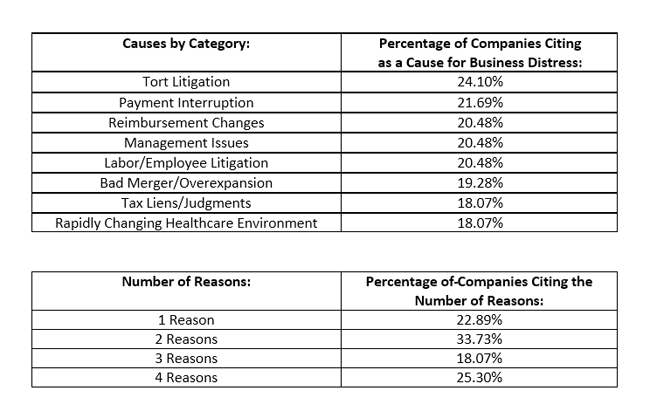Using the information in the Distressed Healthcare Services Research Index, Polsinelli prepared a Special Report that reviewed all qualifying healthcare filings measured in the index in 2014 to ascertain the identified causes. The filings included a total of 83 entities, including hospitals, senior living facilities, surgery centers and various types of healthcare companies.
The report analyzed the filings and found that there were 15 different categories of causes for healthcare filings (plus small numbers for “other” and “unknown”). The eight top causes of distress most cited by struggling healthcare companies were, in order of prevalence:

Note that these top eight causes are each fairly close in size. One of the most interesting findings was that most healthcare companies in distress (approximately 75%) cited more than one cause for their bankruptcy filing.
There are several key conclusions from a detailed examination of the data. Payment interruptions and reimbursement changes, when considered together, were listed as factors in 41% of the healthcare services filings. This included payment interruptions from Medicare/Medicaid reimbursement as well as delays caused by the healthcare company’s own actions (or inactions).
In many cases, when regulatory enforcement litigation was involved, either payment interruption or reimbursement changes were also listed as causes. This includes cases where the enforcement action resulted in a payment delay and cases where the company failed to adapt to a reimbursement change that led to an enforcement action.
The bad merger/overexpansion category included several interesting case studies. It included the classic cases of failure to effectively integrate staff from a merger and overspending or cost-overruns related to expansion, but also involved cases where the merger resulted in inherited or unknown regulatory liabilities that were passed through to the purchasing or surviving entity.
One of the more surprising omissions from the list of causes was the ACA itself. Although it was included in the discussion by a few companies, it was rarely mentioned as a direct cause. There could be several explanations for this omission. The changes related to ACA, while substantial at a macro level, were perhaps seen either as typical government reform at the institutional level, or perhaps were described with more specificity than the broad changes of the ACA. Healthcare is highly regulated and there are frequent changes made to reimbursement rates or other compliance requirements and it is possible the effects of ACA were masked at some level. In addition, although enacted in 2010, ACA and its impact on healthcare is a moving target, with legal and business challenges forcing continuous change.
Outlook for the Future
The healthcare services industry will continue to experience significant distress for the foreseeable future. The effects of ACA and the frenetic pace of consolidation will continue to ripple through all healthcare sectors, creating instability and fragmentation. Rural and stand-alone hospitals will continue to face significant pressure to affiliate or merge into larger hospital groups. Reimbursement rates will keep forcing adjustments in provider strategies as the government attempts to rein in healthcare spending.
The Polsinelli/TrBk Distress Indices are designed as a tool to offer more and better information on distress in the economy generally, and in real estate and healthcare sectors specifically. They tell a story about the businesses on “Main Street,” as well as “Wall Street,” and act as a proxy for overall distress in the market and specific subsectors.